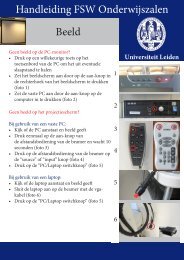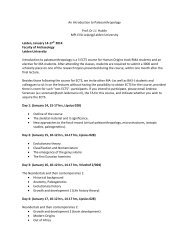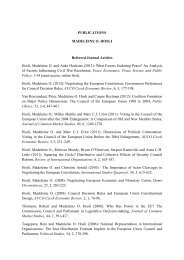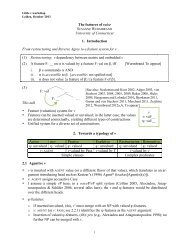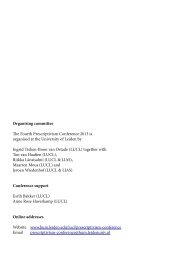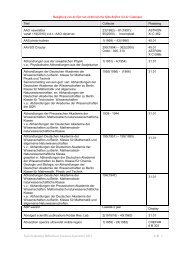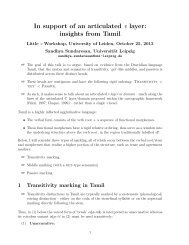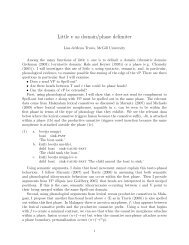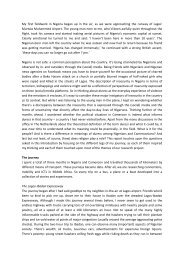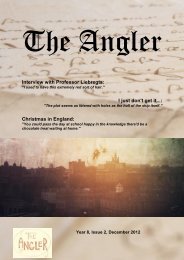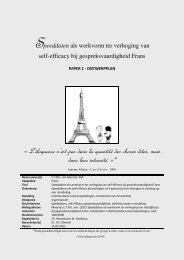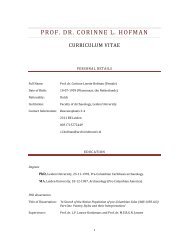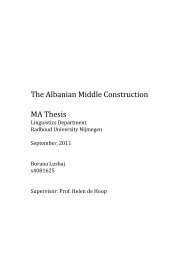Institute for History Annual Report 2010 - O - Universiteit Leiden
Institute for History Annual Report 2010 - O - Universiteit Leiden
Institute for History Annual Report 2010 - O - Universiteit Leiden
Create successful ePaper yourself
Turn your PDF publications into a flip-book with our unique Google optimized e-Paper software.
The Dynamics of<br />
European Identity, 1300-<br />
1700<br />
Description<br />
As the recent wave of concern about national and<br />
cultural identity demonstrates, the question of<br />
how, and with whom, people identify is of continuing<br />
political and social importance. This was<br />
also the case in pre-Modern Europe. Although the<br />
power of the state steadily increased between 1300<br />
and 1700, rulers and administrators remained very<br />
much dependent on good relations with their<br />
subjects, or at least with the local elites. Since these<br />
often identified themselves primarily with the<br />
local community, the region, or other group<br />
interests, the creation of panoptic loyalties was<br />
problematic. This was certainly true in new states.<br />
For this reason, rulers such as the Dukes of<br />
Burgundy consciously concentrated on creating a<br />
supra-territorial elite. Any wise administrator<br />
would expend considerable energy on his<br />
patronage networks. Old media, such as ballads,<br />
pageants and spectacles were used to deliver political<br />
messages, and additional new media were<br />
constantly appearing. Pamphlets and newspapers<br />
created a ‘public sphere’, in which new identities<br />
could be propagated. The development of a sense<br />
of ‘fatherland’ in the highly fragmented Republic<br />
of the Netherlands is an excellent example of this<br />
process.<br />
<strong>Institute</strong> <strong>for</strong> <strong>History</strong><br />
21<br />
Yet, state borders were most certainly not the most<br />
important determinant of identity. On the one<br />
hand regions continued to compete with one<br />
another, while, conversely, transnational networks<br />
often proved to be surprisingly resistant to political<br />
division. Even while their rulers were at war,<br />
trade networks continued to unite the Spanish,<br />
Flemish and Dutch trading communities . Cultural<br />
networks also transcended national borders.<br />
Throughout this period, a recognizably European<br />
intellectual culture prevailed, which played an essential<br />
role in the fast transfer of knowledge. Until<br />
1520, the whole of Europe shared one dominant<br />
religious culture. The schism in the Church in the<br />
sixteenth century not only created trans-national<br />
interest groups and refugee flows, it also created<br />
new confessional alliances in international politics.<br />
There are few areas in Europe in which the<br />
dynamics of identity between 1300 and 1700<br />
manifested itself as clearly as in the Low Countries.<br />
Having started out as a loose conglomeration<br />
of semi-autonomous principalities, personal<br />
unions led to the emergence of a fledgling unitary<br />
state until a Revolt against princely authority led<br />
to the creation of two separate states with their<br />
own clear identity, each of which was related<br />
through its dominant religion to confessional<br />
friends elsewhere in Europe. In this world of<br />
constantly changing borders, strong local political<br />
traditions, an important trading culture and the<br />
interdependence of international markets,<br />
‘identity’ was never monolithic. Yet elsewhere in<br />
Europe too, in particular in the great ‘composite<br />
monarchies’ ruled by the Habsburgs, the relation



